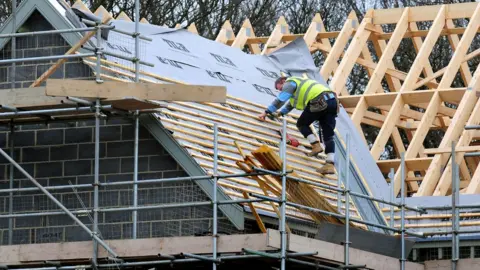Planning approvals for new homes in England have plunged to their lowest level in a decade, raising serious doubts about Labour’s ability to meet its ambitious goal of building 300,000 homes annually.
According to the Home Builders Federation (HBF), the number of approvals has halved over the past three years, dropping to figures not seen since 2014.
Builders attribute the sharp decline to the former government’s controversial decision to scrap mandatory housing targets for local councils.
Although Labour has reinstated the targets, experts suggest much more will be needed to achieve the government’s broader aim of constructing 1.5 million new homes within this parliamentary term.
The promise to accelerate housebuilding is a cornerstone of the prime minister’s economic growth plan, but industry insiders remain skeptical about whether that goal is achievable.
Neil Jefferson, chief executive of the HBF, commented: “The steep fall in planning permissions starkly illustrates the challenge the new government faces to boost housing supply.”
The latest data, compiled by Glenigan, revealed that just 53,379 new homes were approved in the three months leading up to June — a 3% drop from the previous month and a 13% decrease compared to the same period in 2023.
The steady decline, which began at the start of 2022, has brought approvals to a level not witnessed since the housebuilding slump of 2014. This dip was largely attributed to a significant drop in social housing projects.

New Housing Schemes Hit Record Low
In addition to dwindling approvals, the number of new housing schemes initiated has hit a record low since the HBF began tracking this data in 2006.
Builders are focusing on developing fewer sites to avoid potential planning disputes, further complicating the housing crisis. In the second quarter of 2024, only 2,394 new schemes were launched, marking a 9% decrease from the same time last year and half the number seen six years ago.
The most drastic declines in housing approvals occurred in London and the East Midlands, with both regions seeing a reduction of over 40% in the last year.
These figures come amid long-standing criticisms of the London housing market, where former housing secretary Michael Gove has repeatedly pointed to Labour Mayor Sadiq Khan’s alleged underperformance on housing targets.
The Drop in Supply Fuels Rising Rents
The growing housing shortfall is having a direct impact on the rental market, with rents soaring by 8.4% in the year to August, as reported by the Office for National Statistics. House prices climbed by 2.2% during the same period, further exacerbating affordability concerns.
Labour has outlined several changes to the planning system to jumpstart housebuilding efforts, including proposals to simplify building on green belt land and allowing public bodies to issue compulsory purchase orders.
Despite these initiatives, analysts remain unconvinced that these measures will be enough to meet the 300,000-home target, emphasizing the need for a stronger focus on public sector-driven social housing projects.
At the same time, the HBF is advocating for short-term government interventions to make mortgages more affordable. Jefferson said, “The lack of affordable mortgage availability means more support for buyers is needed.” However, economists warn that boosting demand without addressing supply could lead to even higher housing costs.
Labour has also pledged to retain the previous government’s mortgage guarantee scheme while tightening the rules on the right-to-buy program, which offers discounts to tenants purchasing their council homes. This move aims to balance increasing homeownership with the need to maintain an adequate stock of social housing.
READ ALSO: Akwaboah Advises Men Against Polygamy



















